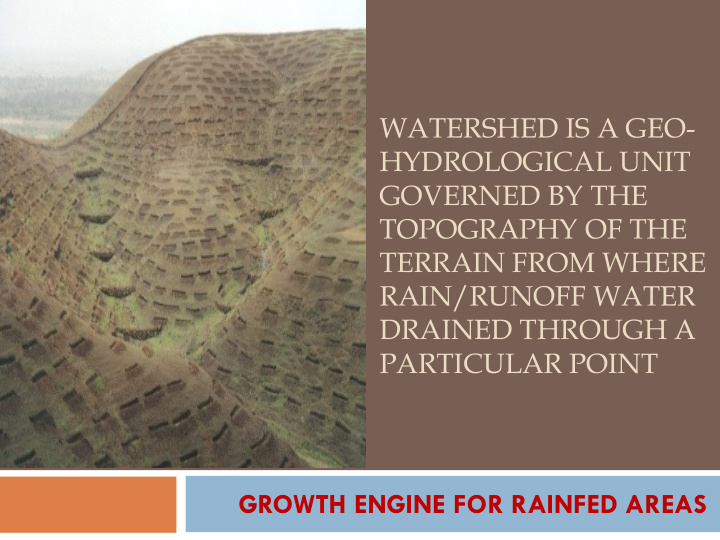



WATERSHED IS A GEO- HYDROLOGICAL UNIT GOVERNED BY THE TOPOGRAPHY OF THE TERRAIN FROM WHERE RAIN/RUNOFF WATER DRAINED THROUGH A PARTICULAR POINT GROWTH ENGINE FOR RAINFED AREAS
Watershed as Planning Tool Watershed constitutes natural spatial frame of hydrologic units for harnessing and utilizing water, soil and forest resources in a sustainable manner within its natural eco-system. Delineation and codification of watershed of a country allows recognizing each hydrologic unit with unique ‘National Code’ that provides a vital platform to synergize all developmental programmes related to natural resources management, rural livelihoods etc., avoiding duplication of interventions of various line departments and ministries
WATERSHED DELINIATION Region to Basin Delineation Catchment to Sub-catchment Delineation Base Map - 1:1,000,000 Base Map - 1:1,000,000 Basin to Catchment Delineation Sub-catchment to Watershed Delineation Base Map - 1:1,000,000 Base Map - 1:1,000,000
WATERSHED DELINIATION Watershed to Sub-watershed Delineation Codification 1 st digit: Region 2 nd digit: Basin 3 rd digit: Catchment Base Map - 1:50,000 Sub-watershed to Micro-watershed Delineation 4 th digit: Sub Catchment 5 th digit: Watershed 6 th digit: Sub Watershed 7 th digit: Micro Watershed Base Map - 1:50,000
Shape of a typical watershed
WATERSHED: IMPORTANT PARAMETERS Soil & geology Topography Meteorology Water Land use & bodies crop cover Institution Planning, Designing and Implementation
WATERSHED: IMPORTANT PARAMETERS TOPOGRAPHY: Slope, drainage lines, depressions, catchments for structures etc facilitates decision making for structural locations and agronomic measures SOIL & GEOLOGY : Estimation of soil loss, infiltration & ground water recharge, type of intervention METEOROLOGY: Quantification of available water & runoff, identification of agro-climatic zone, water requirement etc. CROPS & LAND USE : Selection plants, sustainable farming, crop diversification and allied activities WATER BODIES: To estimate available storage capacity and supplementary requirement INSTITUTION: To plan, design, execute, monitor and maintain through people’s participation
WATER BALANCE Precipitation ET Water Body Land Surface Infiltration Overland flow Stream Channel & inter flow Soil Base flow Infiltration Watershed Watershed discharge Aquifer
SCS method for prediction of runoff Curve Number (CN) for diff. land use 2 P 0 . 2 S max R s P 0 . 8 S max 2540 S ( cm ) 25 . 4 CN max R s : Storm Runoff S max : Maximum Retention Capacity ( A 1 R s1 + A 2 R s2 + A 3 R s3 …… _________________________ R t = A 1 + A 2 + A 3 ……..
Demand and Availability of Water 350 Excess Excess 300 250 Shortage Shortage 200 Rainfall(mm) WR(mm) 150 100 50 0 Jan Feb Mar Apr May Jun Jul Aug Sep Oct Nov Dec
Illustrative Watershed Interventions • Field/Contour/Graded Bunding, Vegetative barriers • Contour farming, strip cropping, mulching, tillage, residue management • Bench/Zingg terracing, Land Leveling Arable • Farm ponds, diversions, safe disposals, grassed water way • Contour/staggered trenching • Stone/retaining walls, Orchard terracing • Plantation: Horticulture, Forestry, Silvi Pasture Non Arable • Water harvesting structures • Gully stabilization measures • Gabion structures, stream bank protection • Percolation tanks, sub-surface dykes Drainage Lines • Check dams
Illustrative Planning of activities Check dams High value crops Afforestation Horticulture
Watershed Management: Processes Topographic & benchmark survey Participatory Planning & decision making Multi disciplinary implementing agency Research & scientific backstop Integrated & conservation farming Water management Livelihood support system Capacity building Monitoring
Strengths of Ministry of Agriculture Survey: Soil & Land Use Survey of India Research: Indian Council of Agricultural Research Multi Disciplinary Teams: Subject matter Divisions and Departments at National level, Subject matter directorates under Agril depts in States Schemes on Integrated farming & agriculture production systems for leveraging natural resources developed Schemes for Water management like NMMI Livelihood through livestock & fishery based activities Strong extension Institutions: ATMA, KVKs, ICAR Trg. Centers, MANAGE
Watershed Based Interventions: Expected Outcome Sustainable deployment of Land Resources Water availability Food Security Livelihood Sustainable Agriculture
THANK YOU
Recommend
More recommend